Key Takeaways
- Select a generative AI course that matches your current Python and machine learning experience to ensure the content and pace are right for you;
- Focus on programs with hands-on, project-based modules using industry tools like PyTorch, Hugging Face, LangChain, and RAG to turn theory into practical skills;
- Earning a verifiable generative AI certificate not only validates your expertise but also boosts your competitiveness and earning potential in today's job market.
Stop overpaying - start transferring money with Ogvio. Join the waitlist & grab early Rewards NOW! 🎁
Generative AI has come a long way. The market is projected to reach $188 billion by 2032, driven by increased adoption across various industries. Naturally, due to developments like these, more and more people have started actively seeking the best generative AI courses.
As you can probably imagine, learning about generative AI is not easy, and I’m not even going to mention “mastering”. To give you a simple idea, it basically involves programming mainly with Python and then teaching the software by feeding it a lot of data. However, it’s way harder than I make it sound.
Though, seeing as you’re reading this article, you probably know this already. That said, I’ve picked some of the best generative AI courses from high-rated platforms, such as Udacity, so let’s get into the list.
Table of Contents
- 1. Generative AI (Enroll Here)
- 2. Generative AI Fluency (Enroll Here)
- 3. Complete Generative AI Course with LangChain and Hugging Face (Enroll Here)
- 4. Generative AI for Beginners (Enroll Here)
- 5. Generative AI Engineering (Enroll Here)
- 6. IBM: Elevating Businesses and Careers with Generative AI (Enroll Here)
- 7. Generative AI Concepts (Enroll Here)
- 8. Why Generative AI Courses are Worth Your Time
- 9. Conclusions
Generative AI (Enroll Here)
If you already have some knowledge about generative AI and somewhat know your way around Python, the Generative AI course is great for taking your skills to the next level. It will transform you from an enthusiast to a capable builder in roughly eight busy weeks.
As you can probably see, the program is tagged intermediate. This is because it demands Python plus database fundamentals, and is officially estimated at two months of six-hour weeks. It’s also worth noting that this Udacity course has a hands-on project-based model, designed around real-world challenges that bridge the gap between theory and practice.

Now, about the course. First comes a crash course in generative AI fundamentals: deep learning basics, PyTorch, Hugging Face, and the ethics of foundation models. Your checkpoint project fine-tunes a huge open-source model with PEFT, proving that you can bend billion-parameter networks on a laptop.
Parameter-efficient fine-tuning (PEFT) is a method of improving the performance of pretrained large language models (LLMs) and neural networks for specific tasks or data sets.
Next, the Large Language Models track demystifies tokenization, transformer attention, and decoding tricks before letting you wire a retrieval-augmented chatbot to the OpenAI API. You leave with a conversational demo that politely answers questions about any corpus you feed it.
In the Computer Vision week lessons, you’ll learn how to turn pixels into prompts by experimenting with GANs, vision transformers, and writing your own diffusion loop. Then, you use Stable Diffusion in a project that swaps the background of a famous painting, basically “art history meets latent-space sorcery”.

Finally, you level up to full-stack Gen-AI engineering: vector databases power long-term semantic memory, LangChain choreographs the whole toolchain, and your capstone project blends it all into a pocket-sized Netflix that doesn’t just recommend shows - it writes, casts, and streams brand-new episodes for you on autopilot.
The guidance comes from a small army of practitioners, including Google ML engineer Victor Geislinger, Stanford-trained researcher Emily McMilin, Advocate’s Brian Cruz, plus DeepMind, BAIR, and Rapid7 veterans. Hence, each lecture lands with war stories, not marketing slides.
Udacity highlights the payoff: various sources show that generative AI engineers earn $157k-$228k, roughly a 50% premium over comparable roles.
Overall, this Udacity course is great for programmers hungry to build. Generative AI program offers a concise, evidence-based path to a verifiable credential and a GitHub portfolio that talks louder than any résumé bullet.
Generative AI Fluency (Enroll Here)
If the first course was a bit above your skill level, and you’re just starting out, the Generative AI Fluency program will be a great place to start. In one short sprint, you progress from headline confusion to clear mental models of how text- and image-based generators earn their magic.
This Udacity generative AI course lasts roughly 7 hours and welcomes absolute beginners, no Python, cloud, or maths required.
The opening lesson supplies plain-language foundations: key terms, common applications, and the architectural thread linking GPT dialogue to AI art.

Lesson two dives into large-language models. You dissect tokenization, attention, and decoding tricks, contrast vendor APIs with open checkpoints, and learn when retrieval augmentation beats raw context stuffing for reliable answers.
Then, you’ll learn about diffusion theory and landmark models such as Stable Diffusion. In addition, you’ll go through a hands-on session with DALL-E and Midjourney that will reveal how guidance scale, seeds, and safety filters steer aesthetic outcomes.
That said, the last session in this Udacity generative AI course tackles production reality - data pipelines, prompt maintenance, orchestration, and spend tracking. Case snippets show how scheduled evaluation keeps hallucinations, bias drift, and token surprises from derailing public releases.
Now, the guidance arrives from:
- Meta veteran, Dr. Uohna Thiessen;
- Berkeley ML lead, Rohan Viswanathan;
- Cape Analytics Scientist, Giacomo Vianello.
The list also includes other specialists whose experience makes each lesson very valuable.
Complete the quizzes to unlock a shareable Udacity certificate, an entry-level generative AI certification worth attaching to LinkedIn. Access sits inside the All Access subscription, letting you sample adjacent AI titles without extra costs.
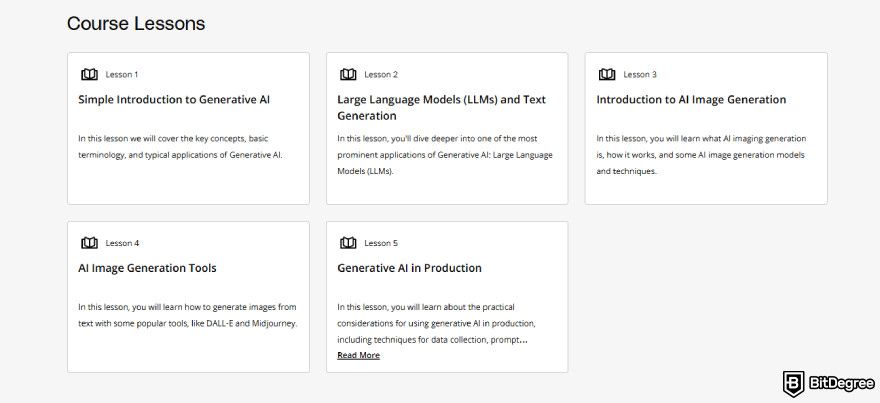
Lastly, if you need rapid orientation before deciding which of the best generative AI courses to pursue next, this one-week sprint is pragmatic, current, and beginner-friendly. Expect clarity, not code, yet leave ready to evaluate buzzwords and recognize genuine innovation.
Complete Generative AI Course with LangChain and Hugging Face (Enroll Here)
Another option that you could definitely place among some of the best generative AI courses is from Udemy. This “Complete Generative AI Course with LangChain and Hugging Face" offers a guided tour from zero to working prototypes, sprinkling code over concepts like powdered sugar on a donut.
Expect roughly 54 hours of video, quizzes, and 62 downloadable labs, enough material to keep your IDE warm for weeks. Udemy lists a 4.6-star average, with over 60,000 learners enrolled.
That said, section one grounds you in generator basics: what transformers do, why attention matters, and how tokens become text. Small, runnable notebooks let you watch a model mumble before you teach it to sing.

The next block introduces LangChain’s chaining logic. You stitch prompts, memory stores, and output parsers together like Lego,[1] then run a multi-step agent that attempts to decode a Shakespeare sonnet, sometimes with comedic results.
Hugging Face comes next. You fine-tune open checkpoints, push them to GitHub, and borrow someone else’s model for instant personalization, much like asking a neighbour for a lawn-mower but adding turbo blades first.
Hugging Face is an open-source Python library that provides access to thousands of pre-trained transformer models for natural language processing.
A dedicated Retrieval-Augmented Generation segment anchors your chatbot’s memory in real documents. By the end, the bot cites sources instead of hallucinating like a sleep-deprived poet, an outcome worth framing.
Deployment lessons round things off: API endpoints, container images, and cloud tricks that keep latency low. Cost-tracking tips also ensure your GPU bill doesn’t sneak up out of nowhere.
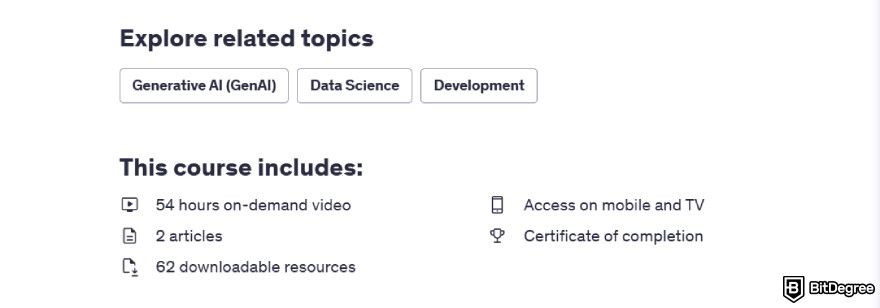
The person responsible for this course is Krish Naik, a popular YouTuber whose analogies land quickly. He once likened vector databases to spice racks, and it somehow works. In addition, the screen recordings feel conversational rather than formal, which can ease the learning curve.
After you finish the full course, you unlock Udemy’s generative AI certification. It isn’t the Hogwarts diploma of tech, but recruiters appreciate proof that you can work with LangChain, Hugging Face, and RAG in one sitting.
Generative AI for Beginners (Enroll Here)
If you’re looking for an approachable way to build a solid foundation in generative AI, this Udemy course is a smart place to start.
It blends fundamental theory with industry-specific examples and a dash of hands-on learning, giving aspiring AI enthusiasts exactly what they need, just as the title promises.
Below is a snapshot of the skills you’ll pick up along the way:
1
Core concepts. Grasp the essentials of generative AI, large language models (LLMs), embeddings, prompt engineering, and fine-tuning.
2
Practical use cases. Discover how organizations across sectors are already putting generative AI to work and gather ideas you can adapt.
3
Future-proofing insights. Explore emerging trends and learn how to stay relevant in a post-Gen-AI world.

4
Hands-on practice. Build (and optionally deploy) your own chatbot to cement what you’ve learned.
5
Continuous-learning roadmap. Leave with clear next steps for deepening your expertise.
As you can see, with this course you can move beyond theory with practical exercises, including building your own generative AI chatbot, getting real-world skills and experience.
The chatbot project is optional. Learners from non-technical backgrounds can simply watch the walkthrough or skip it without missing the course’s core value.
Short, affordable, and consistently well-rated (4.6/5 from more than 37,000 reviews), “Generative AI for Beginners” proves that you don’t need weeks of study - or a hefty budget - to get comfortable with the basics.
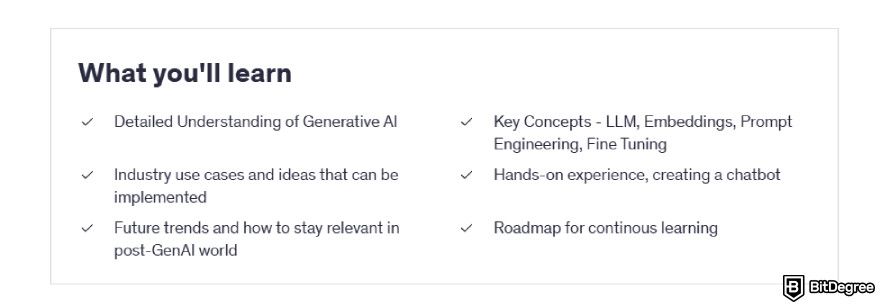
By the end, you’ll understand key terms, see how generative AI is reshaping multiple industries, and appreciate the ethical considerations that come with this rapidly evolving field.
If staying ahead in a tech-driven world is on your agenda, this course is definitely worth a look.
Generative AI Engineering (Enroll Here)
This is a more unique option. Sixteen skill-building courses unfold at your pace with edX’s Generative AI Engineering program. By devoting two to four hours weekly and, over roughly a year and a month, tick off milestones that stretch from foundation theory to advanced model fine-tuning.
You launch with an introduction to generative AI, unpacking how diffusion models, transformers, and GANs conjure text, code, or images from statistical noise, and why responsible development matters as much as creative output.
Then comes the prompt engineering. Short commands become design patterns as you practice temperature control, chain-of-thought scaffolding, and few-shot setups that coax richer, safer responses from large language models.
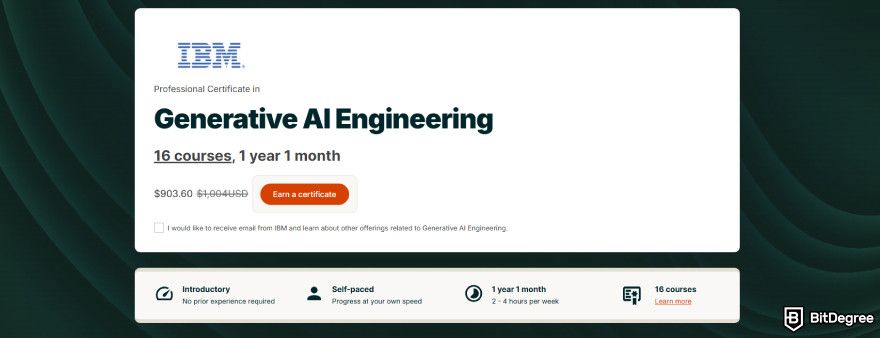
Once you speak the model’s language, you dive under the hood: a two-week sprint on LLM architecture & data preparation walks you through tokenization, vector stores, and PyTorch pipelines that keep compute bills and hallucinations in check.
Transformer internals then take the center stage. You dissect attention heads, positional encoding, and transfer learning, applying them in mini-projects that classify, summarize, and translate live data streams.
Next, advanced modules shift focus to fine-tuning: you experiment with parameter-efficient adapters, RLHF, and Hugging Face workflows that customize open-source LLMs for niche domains without GPU-meltdown budgets.
RLHF is a machine learning (ML) technique that uses human feedback to optimize ML models to self-learn more efficiently.
Afterward, you start using LangChain, FAISS, and retrieval-augmented generation. You build an agent that indexes private documents, fetches context on demand, and answers questions with citations, a portfolio artifact recruiters instantly understand.

That said, by finishing this course, you earn a verified edX certificate plus an IBM digital skill badge, along with the fluency to discuss RAG pipelines or PPO fine-tuning in interviews, exactly the language employers are now listing in AI-engineering job posts.
IBM: Elevating Businesses and Careers with Generative AI (Enroll Here)
As you probably already realize, lots of industries use generative AI to help with various tasks. For instance, you can use artificial intelligence to create marketing copy or even a board-level strategy.
You can receive exactly such knowledge with edX’s course - IBM: Elevating Businesses and Careers with Generative AI.
The opening lesson strips away the jargon surrounding large language and diffusion models, then tours real deployments that already slash costs, shorten design cycles, and unlock new revenue streams across retail, finance, healthcare, and logistics.
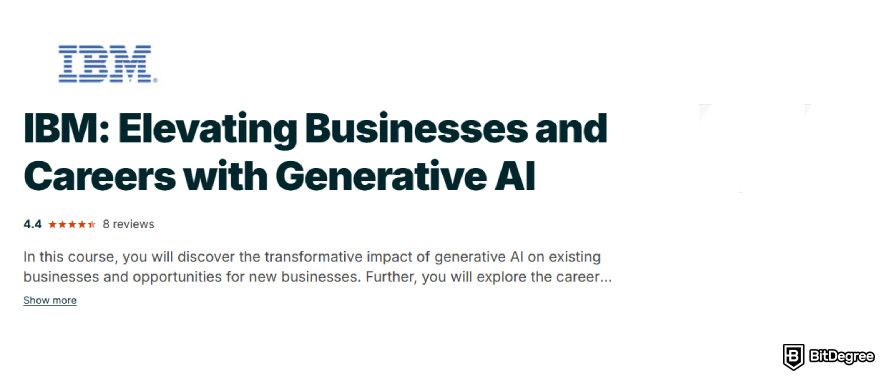
Afterward, you’ll audit everyday workflows, flag high-impact pain points, and outline pilot ideas that balance ambition with risk - ideal fodder for stakeholder pitches or interview talking points.
Additionally, the course has prompt-driven mini-labs that let you test, critique, and iterate live outputs. By the end, “generative” feels less like a headline and more like a tool you can wield confidently at work.
This edX course also provides a dedicated career segment, which spotlights rising roles, such as prompt engineer, Gen-AI strategist, and automation ethicist. At the same time, it maps traditional marketing, HR, and finance tasks to smarter, AI-augmented routines.

Now, the best part is that everything stays beginner-friendly. Therefore, there is no coding, calculus, or GPUs required. The videos are short, they have English transcripts, and ungated readings support both busy professionals and newcomers.
Another great thing about this edX course is that the commitment is light. You will only need to invest about 1 to 3 hours per week over 3 self-paced weeks. Moreover, just by paying $49, you will unlock a verified certificate bearing both the IBM and edX logos.
That said, if you want a concise course that pairs commercial impact with career lift, this three-week program delivers clear, practical, and ready-to-anchor your next AI initiative.
Generative AI Concepts (Enroll Here)
One of the best generative AI free courses with a certificate is DataCamp’s Generative AI Concepts. This program demystifies the models behind ChatGPT’s magic in just two hours. If you’re curious about how tools create text, art, or code, this beginner-friendly primer sets the stage.
📚 Read More: How to Use ChatGPT
Across 14 concise videos and 43 interactive exercises, you’ll explore exactly where generative models sit in the machine learning landscape, why transformers changed everything, and which use-cases, from marketing copy to molecular design, are already transforming industries.
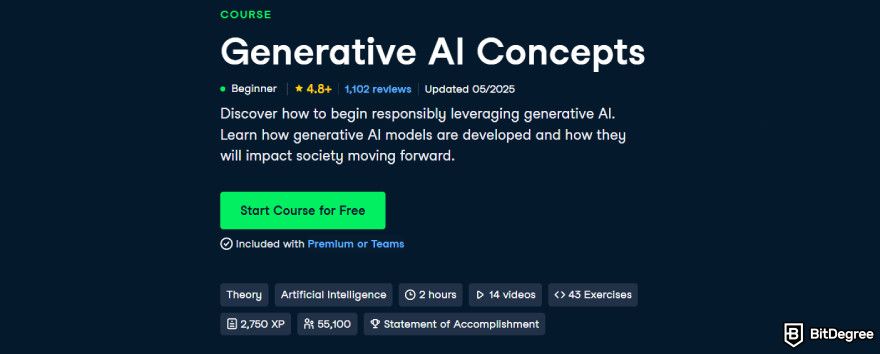
The opening chapter grounds you in definitions, contrasts generative AI with traditional supervised pipelines, and shows early breakthroughs paving the way for today’s text-to-image marvels, giving you the historical recruiters love to hear.
📚 Read More: Best AI Image Generator
Next, you trace a model’s life cycle: curating data, training, evaluating outputs, and fine-tuning for niche tasks. Realistic case studies keep things grounded - no jargon-filled math, just narratives anyone with basic ML awareness can follow.
You will also find a dedicated ethics chapter that tackles bias, copyright, and privacy. This chapter of the course will allow you to practice spotting harmful outputs, trace data lineage, and learn frameworks big-tech teams use to launch responsibly in regulated sectors.
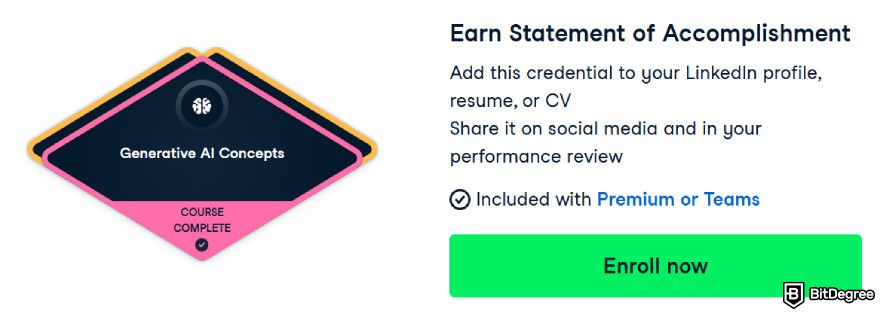
Lastly, the final lesson outlines how generative tools integrate into daily workflows. This includes draft-heavy marketing sprints to code autocompletion and invites you to envision your own “human-in-the-loop” strategy before choosing a vendor or open-source stack.
One more thing to note. The course was created by Daniel Tedesco, a Google data lead, supported by collaborators Amy Peterson and James Chapman.
Why Generative AI Courses are Worth Your Time
Me listing out some random reasons why generative AI courses are worth it wouldn't really be convincing, would it? Therefore, I’ll provide you with some actual situations where knowing how to use generative AI proved to be highly beneficial.
1
LinkedIn data shows postings that mention “generative AI” jumped 3x since 2023, and 1 in 4 new tech ads now demand AI literacy.
2
Recruiters report double-digit salary premiums for candidates who can prompt-engineer or fine-tune models, especially in product and data roles.
3
A Stanford-MIT field study of 5,000 support agents found a 14% boost in tickets solved per hour after rolling out an LLM-based (large language model) assistant.
3

4
Harvard Business Review calls reskilling in AI a core employee value proposition and a hedge against automation risk.
1
Some people speculate that by 2026, 75% of businesses will generate synthetic customer data with generative AI, meaning every function from marketing to compliance will need in-house experts.
5
That said, these are only a few notable examples of why it might be worth considering getting a generative AI certification. To give you a simpler idea, let’s take cars that can drive autonomously. The majority of them heavily rely on artificial intelligence. It might not be gen-AI, but it’s similar.
This perfectly highlights the wide adoption of artificial intelligence. It’s used in all sorts of industries, and it has various subfields.

There is one thing that you should take into account, though. This field requires constant learning and skill development, especially with its rapid advancements, such as machine learning (ML), natural language processing (NLP), and the aforementioned large language model. A large language model is a type of machine learning model designed for natural language processing[2] tasks, including text generation.
Generative AI is also considered a subfield of artificial intelligence that uses Generative models to produce text, images, videos, and other forms of data.
Ultimately, finding some of the best generative AI courses and completing them will help you get started. My own experience showed that attending university might not even be the most optimal path, and learning on your own can be 10 times more effective, and a course can speed up the process and give you the basic knowledge you need to start deep diving.

Did you know?
Have you ever wondered which online learning platforms are the best for your career?
Conclusions
Seeing how the world is rapidly changing, the job market is changing just as quickly. Sources like ABC News and TechCrunch state that there are 75K+ federal layoffs and 20K+ tech layoffs in 2025 alone. Therefore, professionals worldwide are actively searching for ways to safeguard their future.
That said, after going through some of the best generative AI courses, you most likely found something you could take advantage of. However, unfortunately, there aren’t a lot of good quality options that provide a generative AI course for free. Therefore, you will most likely need to pay for the knowledge.
Scientific References
1. Svensgård L.: 'The Enhancement Effect of LangChain on Long Text Summarization';
2. Agüera B.: 'Do Large Language Models Understand Us?'.











